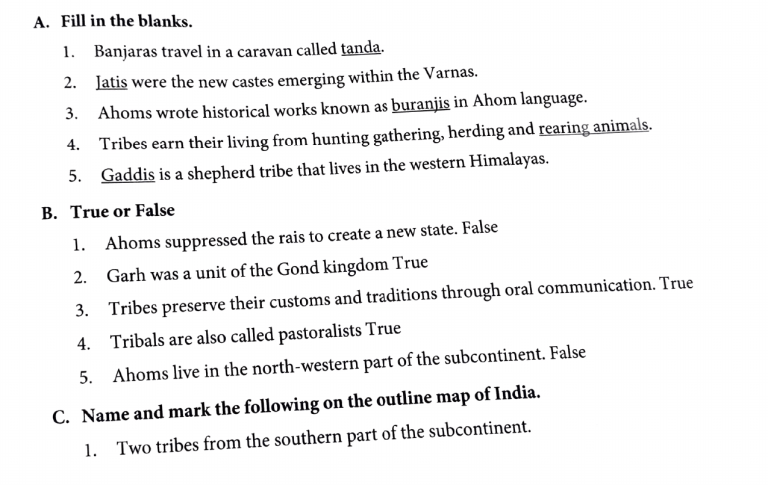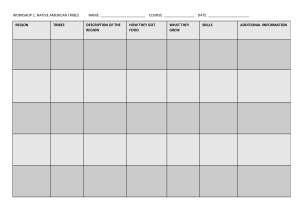Indian Tribes Worksheet: Social Studies Practice
advertisement

A. Fill in the blanks. Banjaras travel in a 1. 2 atis were the new caravan castes called tanda. emerging within the Ahoms wrote historical works known 4. 5. 5. lives Gaddis is a shepherd tribe that B. True or in the western and rearing animals. Himalayas. False 1. Ahoms 2. Garh suppressed the rais to was a unit Tribes preserve their 4. Tribals 5. Ahoms live in the are create a new of the Gond kingdom 3. customs state. False True and traditions through also called pastoralists north-western the following C. Name and mark 1. buranjis in Ahom language. herding their living from hunting gathering, Tribes earn as VarnaS. on oral communication. True part of the subcontinent. the outline map of southern part of the Two tribes from the India. subcontinent. False True m Two 2. tribes ..n from north-western the north the part ot the subcontinent. MAOR INDIAN TRiNES Andoman 71d answer D. Short questions AsafKhan a strong was the defence commander of against Asaf Khan's their Ahoms created Bhuivans. New skills the own state Mughal forces the existing by suppressing required to support an the rule, the Banjaras During Alauddin Khalji's their 5. The sources Sultan of tribal history Chhutiyas (1523) began emerging Khalji by transporting are food grains to Koch-Hajo (1581). the emergence ofsub important traders. They rendered the city markets. as buranjis. such as and historical works art and literature Soon this system of his her was decided by the basis of their occupation. system classified people A person's occupation classification became hereditary. on varna and This led to E. Long answer questions The Durgawati put political system of landlords. nknown a expanding economy. castes or jatis. services to the Gonds D defeated and killed forces, but was the kingdoms of They annexed were which attacked OCcupation-based classes grouped into different particular caste. People were further caste. social and economic standing within each birth in a the basis oftner on members inequality. Their are tied societies in India lack caste hierarchy or class Tribalby other bonds of family and kinship. The rights to their lands and pastures are c toau shared while another, by all members of the tribe. Some tribes are nomadic and others earn their living from agriculture. Most tribes engage place to sucha in livelihood practices, move huning gathering or rearing animals, from one with the aim of utilising the natural resour which they live. 2. The Ahom state was divided into clans or khels. By the first half ofthe 17th century, almost centralised their administration. During wars, every adult male had to Serv serve systems army. At other times, the men were engaged in building dams, irrigation systeiu in and ole a s it provided infrastructure. The village community played a very important role Community. public other the o fthe vilage land to sion peasants. This land could not be taken away even by the king without the perbo theAhom MAJOR INDIAN TRIBES KKARS OCHIS HORRANS JANAA 1.anoh AMAL sars AM KASS CHERE Tropic of Cancer ORAONS ONDS RAKiA BAF KATRARIS 4TABI4N RERA SEL Andaman and Nicobar Islands (India) akshadweep (indio) BADXAS International saoneneoeoo MARAVKRS NDIAN OCEAN Boundary of India

